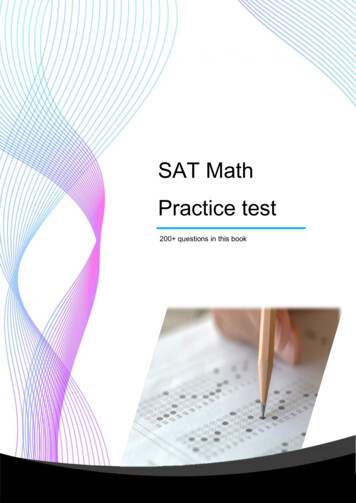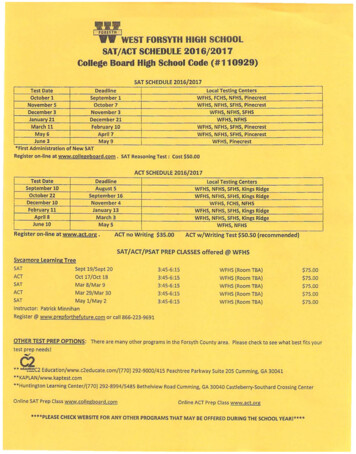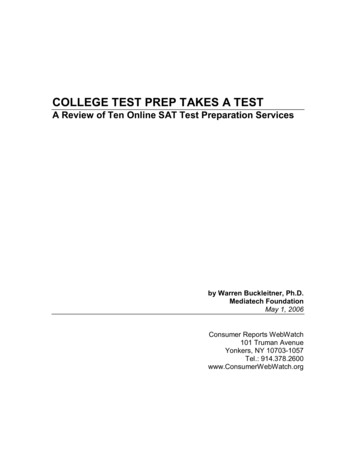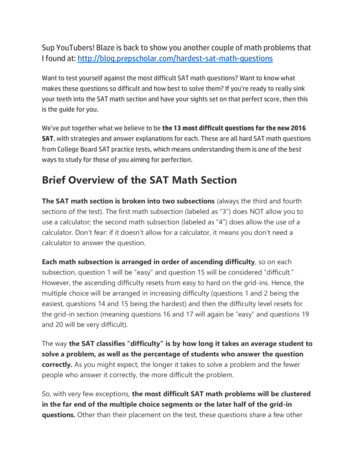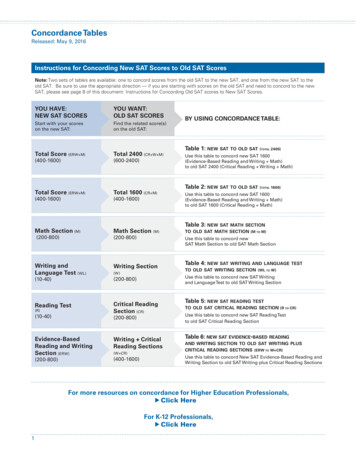
Transcription
1SAT MATH CONTENTS
SAT MATH INTRODUCTIONWelcomeWelcome to the SAT Math portion of the Prep Expert Course! When I was in high school, SAT Mathwas always the section that I scored the highest in. However, even if SAT Math is your worst section,do not worry. We will teach you many effective strategies to ace this section.SAT Math is very important to do well in. Not only does it make up half of your total SAT score, butmany colleges will judge your quantitative skills based on your SAT Math score.Black & WhiteMany students believe the SAT Math section is objective and that the SAT Reading and SAT Writingsections are subjective. However, all sections of the SAT are objective. There are no questions that areopen to interpretation. Nevertheless, the SAT Math section may not be as straightforward as you think.SAT Math question writers often use phrase questions in a certain way in order to trick students. Wewill show you all of the ways that they will try to trick you.High School MathIn order to fully increase your SAT Math score, you must change the way you currently think duringthis section of the exam (unless you are already getting a perfect score). Because of high school mathclasses, we have been indoctrinated to think about math problems in certain ways.In high school, we are often given exams that are not multiple-choice. Therefore, we never think abouthow we can use the answer choices to our advantage when we are given a multiple-choice test.We will show you how to use the multiple-choice nature of the SAT to your advantage. This will requireyou to rethink how you do many math problems. Often, it will not be the same way that you are used todoing problems in your high school math classes.2
SAT MATH INTRODUCTION32400 SAT MathTwo of the biggest differences between the New SAT Math section and the old SAT Math section arethe addition of a no-calculator section and more advanced topics in math.First, many students are afraid that the SAT Math section now includes a no-calculator portion.However, Prep Expert students should have no fear. I actually believe the calculator is a handicapfor many students. I will explain why later, but I have always advocated that students keep calculatoruse to a minimum on the SAT. So it’s actually great news that you can’t use a calculator for certainportions of the SAT Math section! This will force you to practice doing problems without a calculator.The more you practice doing problems without a calculator the more comfortable you will beanswering questions on the calculator-allowed portion of the SAT Math section without a calculator.This will actually increase your SAT Math score!The other major change to the SAT Math section is the addition of more advanced mathematicaltopics. For example, trigonometry is now tested on the SAT Math section, but was not tested on the2400-version of the SAT. However, you only need to know some basic concepts in trigonometry to beable to answer these questions. We will teach you all of the trig concepts you need for the SAT in thiscourse. Therefore, it’s not necessary for you to have taken a full trigonometry class prior to studyingfor the SAT.
5SAT MATHSAT ESSAY FREQUENTLY ASKED QUESTIONSFREQUENTLY ASKED QUESTIONSW H AT I S T H E F O R M AT ?1W H AT ’ S D I F F E R E N T ?2H O W I S S AT M AT H S CO R E D ?3I S S AT M AT H H A R D E R ?4H O W I S S AT M AT H D I F F E R E N T T H A N H I G H S C H O O LM AT H ?5
SAT MATH FREQUENTLY ASKED QUESTIONSWhat Is The Format?61SAT Reading FormatTime80 Minutes Calculator Portion (38 Questions)55 Minutes No-Calculator Portion (20 Questions)25 MinutesQuestions58 Questions Multiple Choice 45 Questions Student-Produced Response (Grid-In) 13 QuestionsContent Heart of Algebra 19 Questions Problem Solving & Data Analysis 17 Questions Passport to Advanced Math 16 Questions Additional Topics in Math 6 QuestionsThe third section of every New SAT will be a 25-min no-calculator Math section with 20 questions.The fourth section of every New SAT will be a 55-min calculator Math section with 38 questions.
SAT MATH FREQUENTLY ASKED QUESTIONS7TimeIn total, there is about the same amount of time dedicated to the SAT Math section on the New SATas there was on the old 2400-version of the SAT. However, on the old 2400-version of the SAT, the70 minutes that were dedicated to the SAT Math section were broken up into three sections of 25minutes, 25 minutes, and 20 minutes.On the new 1600-version of the SAT, there are two sections that makeup a total of 80 minutes(55 minutes and 25 minutes). This means you must stay focused during that 55-minute section for amuch longer period of time. This is not easy, especially since it’s easy to make mistakes on SAT Mathproblems. However, we will give you some techniques on how to stay focused on during such a longsection.QuestionsMultiple ChoiceThese questions offer you 4 possible answer choices. Although there are fewer answer choices thanthe previous 2400-version of the SAT had, the reduction in answer choices doesn’t help you as muchon the SAT Math section as it does on the SAT Reading and SAT Writing sections. Students shouldfocus on arriving at the correct solution on the SAT Math section whereas they should focus on eliminating all of the incorrect answers on the SAT Reading and SAT Writing sections.Whether you have 4 or 5 answer choices on the SAT Math section does not make a big difference. However, when you are guessing on the SAT Math section, the reduction in answer choices can make a difference. But after you learn the Expert Math Strategies in this course, you won’t have to do too much guessing.
SAT MATH FREQUENTLY ASKED QUESTIONS8Student-Produced ResponseThese questions do not give you multiple answers to pick from. Instead, you must grid-in your solutionon the answer sheet. The SAT will accept any way that you write the answer (i.e. as a fraction or as adecimal).Students often believe these questions are more difficult because they don’t have the cushion ofanswer choices to fall back on. However, your approach to student-produced response questionsshould be the same as your approach to multiple-choice questions. In addition, student-producedresponse questions cannot have answers that are negative!ContentHeart of AlgebraPassport to Advanced Math Equations Rewriting Expressions Expressions Quadratic Equations Inequalities Higher Order Equations System of Equations Polynomials FormulasAdditional Topics in MathProblem Solving & Data Analysis Area & Volume Calculations Ratios Lines Proportions Angles Percentages Triangles Graphical Relationships Circles Data Summarization Trigonometric Functions
9SAT MATH FREQUENTLY ASKED QUESTIONS* It’s worth noting that “Additional Topics in Math” only make up 6 questions on the entire exam. Theseare also the questions that relate to geometry and trigonometry. Therefore, it really isn’t necessary tohave gone through an entire course on geometry or trigonometry in order to do well on the SAT Mathsection, given that so few questions will be related to these topics.
SAT MATH FREQUENTLY ASKED QUESTIONSWhat’s Different?1022400 SAT MathNew SAT MathMultiple TopicsLess TopicsLess AdvancedMore AdvancedCalculator in All SectionsNo Calculator Section800 Points800 PointsOne of the major changes the College Board made with respect to the SAT Math section for the New SATwas reducing the number math topics students need to know. As you can see from the previous FAQ,there are a limited number of topics on the New SAT – algebra, data analysis, advanced topics, and additional topics.On the old version of the SAT, the list would be much longer. This reduction in the number of topicsis good news for students. However, the College Board has also increased the depth of knowledgestudents need to have for each topic. So there is the tradeoff. Fewer topics, but more depth ofknowledge required for those topics. We will teach you not only the topics you need to know for theSAT Math section, but also in enough depth that you will be thoroughly prepared for the exam.Another big change is that there is now a no-calculator portion of the SAT Math section. However, as Ialready stated, this is probably a good thing. Every math question on the SAT can be solved without acalculator.In addition, at Prep Expert, we really stress the minimal use of a calculator. In fact, we encourage ourstudents to try to avoid using the calculator as much as possible (I’ll explain why later). By having thecalculator by their side, students often feel more comfortable doing problems.
11SAT MATH FREQUENTLY ASKED QUESTIONSHowever, the calculator cannot help you with the thinking that needs to occur in order to solveproblems. Only your mind can do that. And we will show you many test-taking problem solvingtechniques so that you will no longer feel lost without a calculator.The score allotment to SAT Math has never changed. On the original 1600-verison of the SAT, Mathwas worth 800 points. On the 2400-version of the SAT, Math was worth 800 points. On the new1600-version of the SAT, Math is worth 800 points.This reflects not only the importance that the College Board places on quantitative skills, but also theimportance that many colleges place on math skills. On the 2400-version of the SAT, Math only madeup approximately 33% of your overall SAT score. Therefore, you could get away with not doing so wellon the SAT Math section and still having a decent overall score.However, on this new 1600-version of the SAT, Math is worth 50% of your overall SAT score. So it’svery important to do well on the section. If you are a student who struggles with math in general, thenit is imperative that you learn every strategy we teach for the SAT Math section.
SAT MATH FREQUENTLY ASKED QUESTIONSHow Is SAT Math Scored?3You will receive many different scores on your score report related to SAT Math. However, I would notpay attention to most of them, except your Math Section Score out of 800 and your Total SAT Scoreout of 1600. But for the sake of completeness, I will review what each of the scores means here.Subscores (1-15)Heart of AlgebraThis subscore indicates how well you performed on algebraquestions.Problem Solving & Data AnalysisThis subscore indicates how well you performed on problemsolving and data analysis questions.Passport to Advanced MathThis subscore indicates how well you performed on theadvanced topics in math such as trignometry.Test Score (10-40)MathThis test score indicates how well you performed on all of theSAT Math questions.Cross-Test Score (10-40)Analysis in ScienceThis cross-test score indicates how well you performed onscience passages and questions across the SAT Writing, SATReading, and SAT Math sections.12
SAT MATH FREQUENTLY ASKED QUESTIONS13Analysis in History/Social ScienceThis cross-test score indicates how well you performed onhistory/social science passages and questions across the SATWriting, SAT Reading, and SAT Math sections.Section Score (200-800)MathThis section score indicates how well you performed on theSAT Math section overall.Total Score (400-1600)Reading & Writing MathematicsThis is your SAT score out of 1600 that you will remember forthe rest of your life.
SAT MATH FREQUENTLY ASKED QUESTIONSIs SAT Math Harder?144Overall, I believe the SAT Math section is about the same level of difficulty as the previous 2400version of the SAT. Although there is less math content that you need to know for the New SAT, the content that you do need to know needs to be understood in more depth. This tradeoff between amount ofcontent and depth of content essentially cancel each other out.There are more advanced topics on the SAT Math section than ever before. Previously, the SAT only testedup to Algebra II. But now, the SAT tests trigonometry. However, there is very little trigonometry tested onthe New SAT.If you recall, there are six questions related to advanced topics on the SAT Math section. More likelythan not, all six of those questions will not be trigonometry. So you are likely going to encounter only2-3 trigonometry questions on the New SAT Math section. In addition, the trigonometry tested is nottoo advanced – sine, cosine, and tangent.Finally, with the addition of the no-calculator section to the SAT Math section, I believe Prep Expertstudents have an advantage over other students. Because we train you to solve all problems withouta calculator, you will have no problem with this section. Many other students may struggle without acalculator.Overall, the new SAT Math section is easier if you are a student who typically does well on mathbecause of the reduced content and fewer answer choices. If you are a student who typicallystruggles with math, the New SAT Math section will likely be harder for you due to the more advancedcontent that you need to understand in-depth.No matter what type of student you are, Expert Math Strategies will help you ace this section of theSAT.
SAT MATH FREQUENTLY ASKED QUESTIONS15How Is SAT Math Different Than High School Math?5SAT Math is different than high school Math. Many students who do well in high school Math often dopoorly on SAT Math. This makes perfect sense to me. In high school Math, teachers train studentsto use a top-down approach. Because you are not given answer choices on most math tests in highschool, students never think to use answer choices to their advantage.But on SAT Math, you are given answer choices. So we need to reengineer the way we think aboutSAT Math problems using a bottom-up approach. This means using the answer choices to ouradvantage. Let me show you an example.Top-Down Approach (Traditional High School Math) x 52 2 3 Without any answer choices in high school, you would solve this problem using the traditionaltop-down approach: x 2 49 x 98
SAT MATH FREQUENTLY ASKED QUESTIONS16Bottom-Up Approach (Using Answer Choices to Our Advantage) x 52 2 3 (A) 49(B) 55(C) 98(D) 110Plug in 98: 98 52 2 3 While the top-down approach may seem simpler on this easy problem, we will find that the bottom-upapproach may be useful on harder problems. The example above is not to illustrate the advantages ofthe bottom-up approach just yet (as I agree that the traditional topdown approach is probably easierin this scenario), but to show you that we need to reengineer our traditional way of thinking aboutmathematics in order to take advantage of the multiple-choice nature of the SAT.
SAT MATHEXPERT PRINCIPLESC A P I TA L I Z E O N CO M P L E X I T Y1P U T P E N C I L TO PA P E R2LABEL EVERY THING3HIGHLIGHT QUESTION4VERIFY EACH STEP5
SAT MATH EXPERT PRINCIPLESCapitalize On Complexity?181Just as we do for every other section of the SAT, we will cover 20 Expert Strategies to help you ace SATMath. However, I have also created 5 Expert Principles for this portion of the exam. These principles areapplicable to the entire SAT Math section and not just to specific problem types. You should keepthese principles in mind as you work through all SAT Math problems.The first Math Expert Principle is Capitalize on Complexity. SAT Math problems are ordered from easyto hard. At the beginning of a section, you will encounter easier problems. At the end of a section, youwill encounter harder problems. Make sure you have enough thinking power left at the end of an SATMath section to tackle the most difficult questions.You should keep in mind that the order of difficulty resets when you get to the student-producedresponse questions at the end of each SAT Math section. For example, on the no-calculator 20question SAT Math section, the order of difficulty will go from easy to hard on the first 15 multiplechoice questions. Then, the order of difficulty will go from easy to hard on questions 16 through 20 –the student-produced response questions.We should capitalize on the ordered complexity of the SAT Math section to help us score higher onthis part of the exam. But first we need to understand what makes an SAT question “easy” or “hard.”SAT Math questions are considered “easy” or “hard” based on the number of students that answer aparticular question correctly. SAT Math difficulty will follow these guidelines: Easy Questions – Most students answer these questions correctly. Medium Questions – About half of students answer these questions correctly. Hard Questions – Most students answer these questions incorrectly.
19SAT MATH EXPERT PRINCIPLESKnowing the above information can help us in capitalizing on the complexity of the SAT Mathquestions. For example, if an easy question is taking you an extraordinarily long time to solve or you arestarting to use very complex calculations, you should stop. Since you know that the problem is an easyquestion that most students answer correctly, you are likely doing something wrong. Try going back tothe beginning of the problem and solving it in a way that you might not have originally seen.In addition, when guessing on an easy SAT Math question, you should be aware that the answer willbe somewhat “obvious.” Obvious answers are ones that can be easily derived from the numbers orvariables in the question.On the other hand, if a hard question only took you a couple of seconds to solve, then you shouldstop. Since you know that most students answer hard questions incorrectly, then you may have donesomething wrong. Hard questions typically require students to put in more time and effort in order tosolve them. Try going back to the beginning of the problem and seeing if there was something that youoriginally missed.Of course, sometimes using Math Expert Strategies will help you solve hard SAT Math questionsextremely fast. Because Math Expert Strategies are not the traditional high school ways to solve SATMath problems, the SAT is rewarding you for your unconventional problem solving skills.In addition, when guessing on a hard SAT Math question, you should be aware that the answer will likelybe non-obvious. non-obvious answers are ones that cannot be easily derived from the answerchoices. Often times, these answer choices are “ugly” looking. They look like no one could everderive that answer choice; however, it may be to your advantage to pick these complex-lookinganswer choices when you are guessing on hard SAT Math problems.
SAT MATH EXPERT PRINCIPLESPut Pencil To Paper202You may recall that Put Pencil to Paper is actually General Expert Strategy #10. However, I amreemphasizing it here as a Math Expert Principle because I believe it is particularly essential to scoringhigh on the SAT Math section. Putting Pencil to Paper means writing down every detail as you workthrough the SAT. This concept is more important on SAT Math than any other part of the SAT. Your biggestweapon on the SAT Math section is not your calculator. It is your pencil.Your mind has two aspects: working memory and thinking power. Working memory and thinkingpower are inversely related. The more that you use your working memory, the less thinking power youwill have.By Putting Pencil to Paper, your mind no longer has to store so much information in its workingmemory. You have more thinking power to accurately solve problems. For example, do not try toremember that x 2 or that answer choices B and D are definitely incorrect. Instead, simply writedown that x 2 and cross out that answer choices B and D. Details such as these do not need totake up space in your working memory.On SAT Math, it is imperative to Put Pencil to Paper on every problem. There are so many smalldetails on each SAT Math question that you don’t even realize you are storing in your mind. Forexample, if a problem states that the slope of a certain line is 2, then you should put your pencil topaper and actually label that line as having a slope of 2. You could just leave the line unlabeled andremember that the slope is 2. However, this approach will take up working memory and thereforedecrease your thinking power.
21SAT MATH EXPERT PRINCIPLESYou will be pleasantly surprised at how powerful this technique is on the SAT Math section. Problemsthat you initially thought were unsolvable suddenly become immediately obvious. Write down as muchas you can on the SAT Math section. Draw diagrams, label diagrams, write out equations, substitutenumbers, circle unknowns, etc. The more that you keep your pencil glued to the test booklet, thehigher your SAT Math score will go. Think with your pencil!
SAT MATH EXPERT PRINCIPLESLabel Everything3Similar to Putting Pencil to Paper, this Math Expert Principle Label Everything also frees up ourthinking power during the SAT Math section. When there is a diagram, chart, or other picture on theSAT Math section, make sure you label everything you can.Although this principle is very similar to the previous one, I created a separate Expert Principle herebecause it’s so important to label items on SAT Math. Yet when I see many students’ SAT exams afterthey have taken the test, I see that they have not labeled all of the given diagrams on the SAT Mathsection.Not only should you label what is given to you by the question, but you should over-label.“Overlabeling” means labeling everything possible about a diagram – even if the SAT does notspecifically give you that information in a problem.If you are given the side lengths of the triangle, you should label the lengths of each of the sides. Thisis a no-brainer. However, to take your labeling one step further, you should also label the height of thetriangle. Even though the SAT may not specifically ask about the height of the triangle, you should stilllabel it. The height of a triangle is often used to find the area of the triangle, which is a common itemthat is needed to solve geometry questions related to triangles. Having the foresight to label items thatare not already given to you on SAT Math diagrams is what separates good SAT Math scores fromgreat SAT Math scores.You should also remember to label neatly. Although this may sound simple, many students missquestions because of sloppy labeling. In addition, make sure to note diagrams that are not drawn toscale. If the diagram doesn’t specifically say, “Figure Not Drawn to Scale,” then you can assume thatthe diagram is drawn to scale. Label according to whether it is or isn’t drawn to scale.22
23Highlight QuestionSAT MATH EXPERT PRINCIPLES4Have you ever solved for x on an SAT question, but ended up getting the problem wrong because theproblem was actually asking for the value of 2x? Most students have had this experience before. This happens becomes we become so engrossed in our calculations that we forget what the original problem wasasking for. We are so happy that we finally solved the problem that we forget what the original problemwas asking for.We are so used to our high school math classes being straightforward (i.e. asking for the value of x).However, the SAT is often not as straightforward. In fact, it’s downright tricky.In order to prevent losing sight of the task at hand, you should make it a point to highlight thequestion. Obviously you will not have a highlighter with you during the SAT. But you can still “highlight”the question by circling it. You should circle the part of the question that asks you exactly what youneed to find.For example, the question might ask for the value of x, 2x, or x2. Whatever the question asks you tofind should be what you circle. Not only will this clearly indicate what you need to look for as you aresolving the problem, but it will also focus your attention.Many of the SAT Math problems are lengthy word problems. With so much information given, it’s easy toget overwhelme. By highlighting the unknown value of an SAT Math question, your mind can focus onwhat you need to eventually find.While highlighting the unknown value is helpful, it won’t be much use if you don’t look back at whatyou have circled after you have finished solving a problem. After solving a question, many studentsoften go directly to the answer choices and choose the one that matches what they solved for.
SAT MATH EXPERT PRINCIPLES24Before going to the answer choices, you should go back to the original question and look at theunknown that you highlighted. Make sure that what you circled in the question is also what you solvedfor while doing your work. If the two don’t agree, you must adjust your answer to find the highlightedunknown.Although this sounds like a simple principle, it’s an important one. If you don’t check that you solved forthe correct value after every math problem, then you will make a couple of silly mistakes that will cost youbig on the SAT Math section.In addition, think in real world terms. If you are on a student-produced response question that asksabout number of pencils, don’t fill in 50.3 as your answer. You cannot have 50.3 pencils. Instead, youshould fill in 50 or 51 (depending on if the question says to round up or down).Highlight the question by circling or underlining the unknown so that the worst thing possible doesn’thappen to you: getting a question wrong because you forgot what it was originally asking for despitesolving the entire problem correctly.
25Verify Each StepSAT MATH EXPERT PRINCIPLES5When do you check your work on an SAT Math section? If you are like most students, you likely checkyour work at the end after you have finished all problems on the math section.However, no student in the history of the SAT has ever found a mistake after they have completelyfinished an SAT Math section. Okay, maybe I’m being a little dramatic. But chances are that you willnot find an error after you have completed all of the problems on an SAT Math section.The reason students do not find errors after they have completed an SAT Math section is that theyare typically only “confirming” answers rather than really scrutinizing them to check for mistakes.Confirming answers is different than looking for errors. When you are done with an SAT Math section,you are likely only reviewing your work.Rarely do you ever dive deep enough into a problem that you will find an error in the problem. Inaddition, there is limited time leftover at the end of an SAT Math section. Most students don’t havemore than 5 minutes left. This causes students to rush even more while they are checking their work.This rush against time results in even fewer errors found at the end of an SAT Math section when moststudents check their work.If checking your work at the end of an SAT Math section doesn’t work, what does? Checking yourwork as you work through each problem. As you are solving a problem, you should Verify Each Step.For example, you should verify that 3 x 12 actually does equal 36 while you are solving a problem. Youshould verify that the formula for the area of a triangle really is ½ bh.Verifying each step is a much more effective way to check your work because you are fully engrossedin a problem. You will not have to reenter the details of a particular question because you are alreadyknee-deep in those details.
SAT MATH EXPERT PRINCIPLES26In addition, verifying each step as you go will help prevent frustration. Sometimes a simple arithmeticerror can cause your answer to be off despite doing all the correct steps. This can throw you off yourgame since you know that you are solving the problem correctly. Verifying each step will help youavoid small frustrations like this during the test and ultimately boost your SAT Math score.Although Verifying Each Step may make you take longer to complete each SAT Math section, you will alsobe more accurate. You may not have as much time at the end of an SAT Math section as you are used to.However, the time that you used to have at the end of an SAT Math question was useless anyway. This isessentially a story of the tortoise and the hare. Would you rather be the overconfident, fast hare or theslower, more accurate tortoise who still finishes the race?
SAT MATHEXPERT STRATEGIESS U B S T I T U T E A B S T R A C T S W I T H TA N G I B L E S ( S AT )1SUBSTITUTE ANSWERS IN PROBLEM (SAP)2J U S T G E T S TA R T E D3D I TC H T H E T E C H4S K E TC H A D I A G R A M5A C E E Q UAT I O N S6A C E I N E Q UA L I T I E S7ACE EXPRESSIONS8ACE EXPONENTS9A C E D ATA A N A LY S I S10ACE GRAPHS11A C E C E N T E R O F D ATA12A C E U N I T CO N V E R S I O N S & R AT E S13A C E R AT I O S & P E R C E N TA G E S14ACE LINES & ANGLES15ACE TRIANGLES16ACE CIRCLES17ACE 3D FIGURES18A C E CO M P L E X N U M B E R S19ACE TRIGONOMETRIC FUNC TIONS20
SAT MATH EXPERT STRATEGIESSubstitute Abstracts With Tangibles (SAT)281Perhaps the most important strategy for the SAT Math section is to Substitute Abstracts withTangibles (SAT). The primary way to use this strategy is to create your own numbers to plug in forvariables in algebraic equations. However, this is not the only use of SAT. You can Substitute Abstractwith Tangibles on a variety of other questions including, but not limited to, word problems, geometryquestions, and proportions.The major advantage of Substitute Abstract with Tangibles is that our mind works with tangibles. Itis much easier to comprehend that I have 100 cows than it is to comprehend that I have x cows. Bytaking the abstractness out of problems, we can often solve them in ways that are far easier than traditional high school math classes teach.One of keys to substituting abstracts with tangibles is to pick the right numbers to substitute. Itdepends on the problem that you are working on, but I often initially substitute the number 2. I like 2because it is a small integer that is easy to work with. You want to avoid substituting 0 or 1 becausethis will often result in multiple answer choices giving you the same answer. Of course, if you waresubstituting for an angle measure, then 2 might not be the best number to plug in. Instead, you mightwant to substitute an angle measure of 60 degre
The score allotment to SAT Math has never changed. On the original 1600-verison of the SAT, Math was worth 800 points. On the 2400-version of the SAT, Math was worth 800 points. On the new 1600-version of the SAT, Math is worth 800 points. This reflects not only the importance that the College Board places on quantitative skills, but also the


